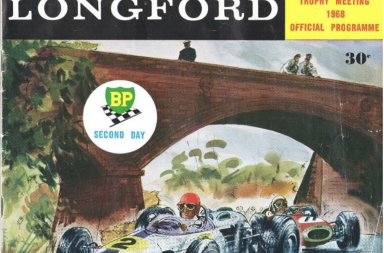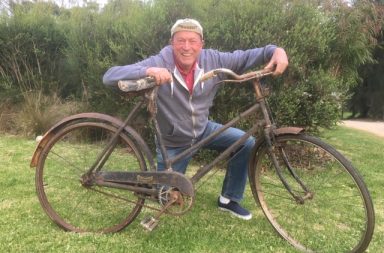NEIL KEARNEY
The historic Tasmanian property of Woolmers reminds me of the cup, saucer and plate set that mum kept in the china cabinet. It was a gift from auntie ‘Win’ and held pride of place, although it didn’t have much competition alongside the chipped vase my sister won for Miss Longford sports girl 1963 and the towel I received for best backman at Perth seconds. The cup, saucer and plate set had sentimental value to mum, so much so that we never used it.
Being a town boy, I didn’t have much appreciation of the district’s colonial heritage, except that we carted farmers’ hay bales on uncle Norm’s truck when we should have been studying for exams. And, as a descendant of convicts, I’ve always pitied those poor buggers who got flogged for pinching a measly loaf of bread to feed their starving families.
We Longford kids used to fish on the banks of the Macquarie River alongside Woolmers Bridge, catching glimpses of the historic buildings and thinking how aloof and unreachable they were, just like mum’s cup, saucer and plate set.
Sometimes we spotted Tommy Archer darting here and there, looking across at us. Tommy was the last occupant of Woolmers, which is one of the reasons why the property is so unique. Because Tommy lived for several decades in just one or two rooms and virtually entombed the rest of the house, it became a time capsule, enshrining all its heirlooms and secrets. After Tommy passed away, the people who ventured into the house felt like the archaeologists who uncovered Egypt’s Valley of the Kings.
Woolmers is an untouched relic of Australia’s colonial era, one of the most intriguing and precious estates in the country.
Over the years I’ve stayed in the cottages at Woolmers and its neighbour Brickendon, the two local properties on the UNESCO World Heritage list. Brickendon is a working farm that lives and breathes history. Louise and Richard Archer make rural tourism accessible to everyone. There are lots of activities, animals to feed and cottages that are family-friendly. The guests’ cottages at Woolmers are original, with creaking staircases and low ceilings, but they’ve been updated to accommodate the needs of modern travellers. You can sit in the living room of the cottages, with their doilies and decanters of sherry, and feel like you’ve been transported back to the 19th century. With the winding hedgerows and views to die for, Woolmers and Brickendon are two of the most beautiful properties in the country.
When I stayed at Woolmers a few weeks back, I was stunned by the extraordinary transformation the estate has recently undergone. The National Rose Garden, the swinging bridge which connects Woolmers and Brickendon, and the new visitor centre have taken it to a whole new level.
The World Heritage-listed site has the potential to do for the Northern Midlands what MONA has achieved for Tasmania. Visitor numbers to the island are increasing every year and two of the most historically significant properties in the country must rate highly on tourists’ to-do lists. The remnants of Tasmania’s dark past really can help give our region a prosperous and proud future. The 200 year-old Woolmers estate has the oldest woolshed in Australia that’s still being used. Just down Woolmers lane, on the outskirts of Longford, is the oldest continuously-used racecourse in the nation. The new swinging bridge spans the Macquarie and links Woolmers and Brickendon via a delightful walking track. I can’t imagine a more pleasant walk than along the riverbank from Woolmers to Brickendon.
Several million dollars have gone into building the new visitor centre and galleries at Woolmers. The centre, which will be officially opened by the Premier in February, has the potential to become the most attractive function and wedding venue in northern Tasmania. Whichever way you point a camera, the photos will be stunning. The rose garden and rotunda present a colourful foreground and the backdrop is as spectacular as any you’d find in Provence or Tuscany. You can gaze westwards over the rolling fields towards the Western Tiers, or watch the sunrise over Ben Lomond. The new visitor centre will be superb for exhibitions, festivals, reunions, celebrations, degustation lunches and so much more. It’s a brilliant opportunity for this area.
The nicest thing about tourism is that you don’t have to dig holes or knock down trees. You simply welcome visitors to your area and give them a good experience. The spin-off from a successful tourist operation is to boost local businesses, provide long-term employment and engender community spirit. As tourist numbers at the heritage sites grow, there’ll be increased demand for all manner of services, especially accommodation and meals in nearby Longford, Evandale, Cressy, Perth, Campbell Town and Launceston. The people of Ballarat can testify how Sovereign Hill has provided sustained employment for hundreds of people and has become a source of pride for their region. Sovereign Hill is a man-made attraction, whereas the integrity of Woolmers and Brickendon must never be compromised. Because of the heritage status, there are many restraints on what can be done. But – for the Woolmers-Brickendon site to fulfil its potential – it will need to appeal to all ages and it should be promoted and marketed more aggressively around Tasmania and to mainlanders. The participation of the whole community is crucial to the Woolmers-Brickendon site’s future. It must involve the old and young, people off the land and of the towns. Now is the time that everyone in Northern Midlands should be encouraged to see Woolmers, and to realise its unique beauty. I suspect most locals have not visited Woolmers-Brickendon and don’t appreciate why it’s on the UNESCO World Heritage list. If you take a tour at either property, you’ll be stunned by the experience.
For tourism to help provide a bright future for the Northern Midlands, everyone needs to put out the welcome mat.
Mum’s old cup, saucer and plate set was way too precious to be used, but our World Heritage site needs to be shared – it has to become a place that we all love to visit.
www.neilkearney.net.au



